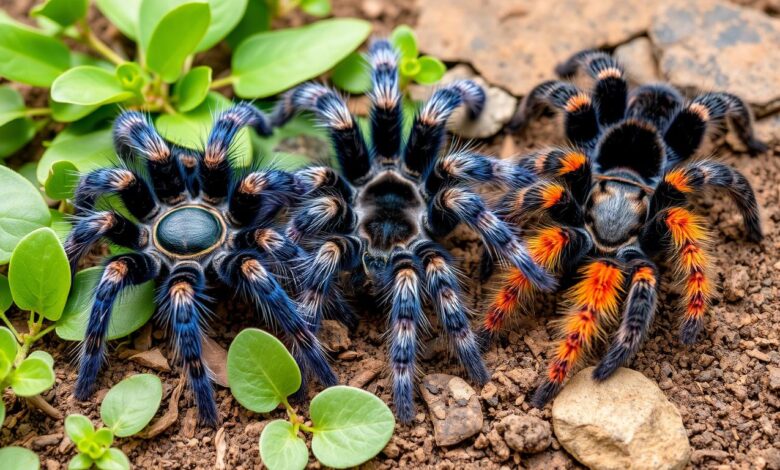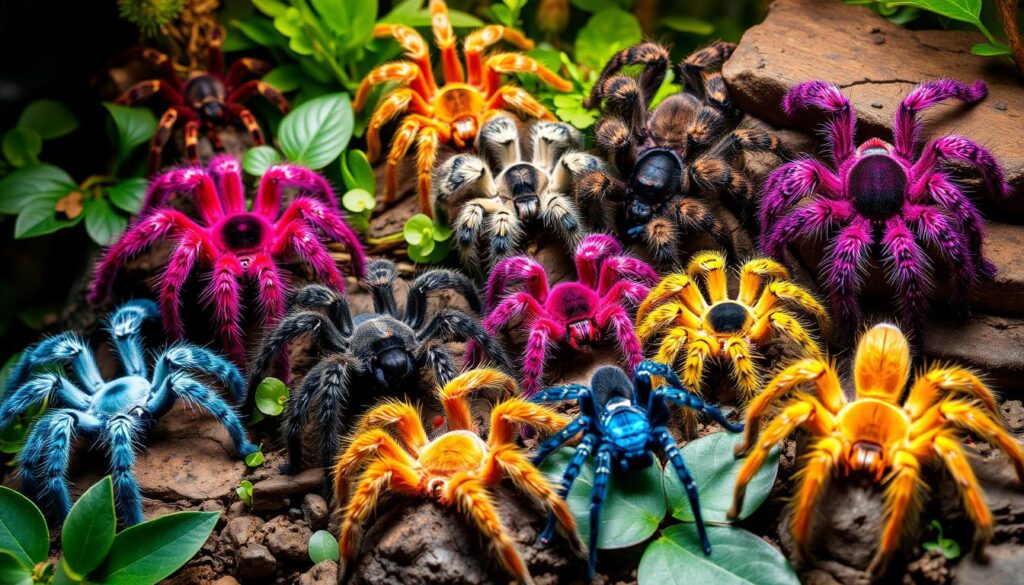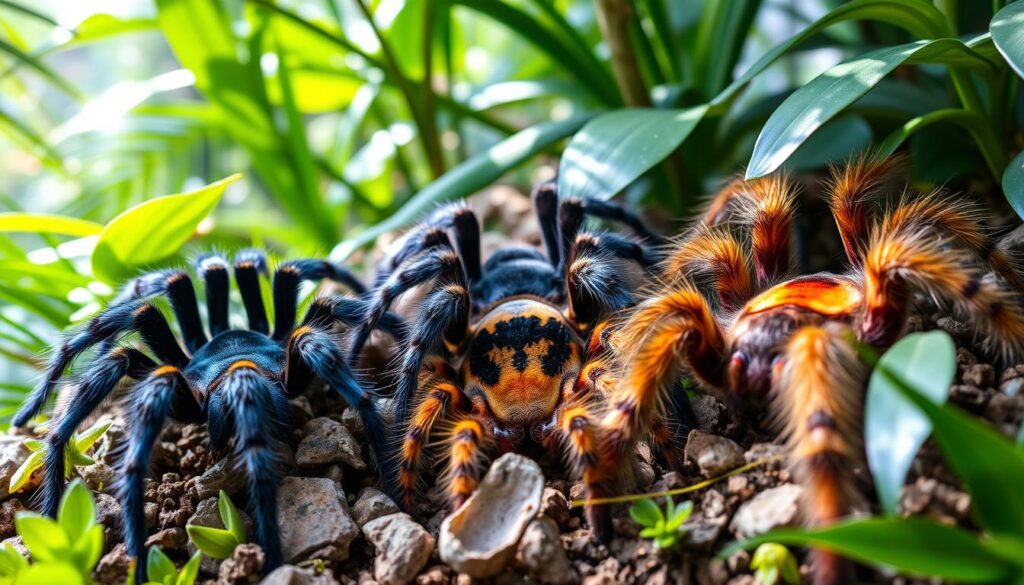Tarantulas for sale

Tarantulas are fascinating and often misunderstood arachnids that make unique and captivating pets. This guide will cover everything about tarantulas for sale. It includes popular tarantula species and their traits, setting up the perfect tarantula enclosure, and how to care for them. It also talks about tarantula feeding, tarantula handling, and safety tips. Whether you’re new to tarantula ownership or have been a fan for a while, this article has what you need to know for a great tarantula ownership experience
.Introduction to Tarantulas: Explore the World of These Incredible Creatures
Tarantulas are fascinating spiders that belong to the Theraphosidae family. They live in many parts of the world. With more than 900 different tarantula species, they are known for their unique traits and interesting ways of behaving. People often think tarantulas are aggressive, but they are not usually a threat to humans.
Debunking Myths and Misconceptions about Tarantulas
Many people don’t understand tarantulas well. They are often seen in a bad light because of tarantula myths and misconceptions. We will look at and clear up some common myths about these amazing spiders:
- Tarantulas are not aggressive and rarely bite humans. Their venom is usually mild and not dangerous.
- It’s not true that tarantulas jump at or attack people. They are usually calm and try to avoid fighting.
- Tarantulas don’t spin complex webs to catch prey. They use their speed and special hunting skills instead.
- Tarantulas can’t give humans deadly diseases. They are not carriers of any known illnesses in humans.
Learning about the real tarantula characteristics and behaviors helps us see them in a new light. Let’s explore the world of tarantulas and see the beauty they bring.

Popular Tarantula Species for Sale: Unveiling the Diversity
The world of tarantulas is full of fascinating species, each with unique traits and behaviors. When you look into the tarantula market, you’ll find many options. From the gentle Brachypelma smithi to the quick and defensive Poecilotheria metallica, there’s something for everyone. Let’s explore the key characteristics, behaviors, and care needs of some top tarantula species for sale.
Characteristics and Behaviors of Different Tarantula Species
The Texas brown tarantula (Aphonopelma hentzi) is a favorite among tarantula lovers. They mate from late August to October, and females can live 20 to 30 years. Males live a few years after mating. A male can mate with over 100 females, and the females lay hundreds of eggs that hatch in 45 to 60 days.
The Poecilotheria metallica, or Metallic Tarantula, stands out with its fast speed and defense. They are not easy for beginners but are loved for their beautiful colors and patterns.
The Brachypelma smithi, or Mexican Red-Knee Tarantula, is known for being calm and easy to handle. They have bright red-and-black colors and are a favorite among tarantula fans of all levels.
| Tarantula Species | Characteristics | Behaviors |
|---|---|---|
| Texas Brown Tarantula (Aphonopelma hentzi) |
|
|
| Metallic Tarantula (Poecilotheria metallica) |
|
|
| Mexican Red-Knee Tarantula (Brachypelma smithi) |
|
|

Setting Up the Perfect Tarantula Enclosure: A Step-by-Step Guide
Creating the perfect tarantula enclosure is key for your tarantula’s health and happiness. This guide helps both new and experienced owners create a great home for their tarantulas.
Start by picking the right tank size. Your tarantula should have enough room to move around without feeling trapped. Aim for a tank that’s at least four times the size of your tarantula’s leg span.
Next, choose the right tarantula substrate. A mix of potting soil, coconut fiber, and sphagnum moss is good. It keeps the right amount of moisture and lets your tarantula dig.
- Add hiding spots and decorations for a natural look. Use cork bark, smooth rocks, and live plants (if they fit your tarantula’s needs). This helps your tarantula feel safe and at home.
- Make sure your tank has good air flow. Choose a tank with a lid or screen top. This keeps air moving and stops too much moisture.
- Keep the right temperature and humidity. The best levels vary by tarantula type. Look up what your tarantula likes.
Follow these steps to make a great tarantula enclosure setup. This will help your new pet stay healthy and happy. Remember, the secret is to know and meet your tarantula’s specific needs.
Tarantula Care and Feeding: Essential Tips for Keeping Your Eight-Legged Friend Healthy
Caring for a tarantula needs special knowledge and skills. We’ll cover the key parts of tarantula care and feeding. This includes the right diet, water, and how to handle the molting process. Learn how to care for your tarantula to keep it healthy and happy.
Understanding Tarantula Molting and Ensuring a Successful Process
Tarantulas shed their skin during molting to grow. This is a key part of their life. It’s important to know how to help your pet during this time. Good tarantula molting care means keeping the right humidity, giving them a safe spot, and not disturbing them. This helps your tarantula molt successfully and without stress.
| Tarantula Health Essentials | Description |
|---|---|
| Tarantula Diet | Tarantulas eat live prey like crickets, mealworms, or small rodents. It’s key to give them the right amount and how often to eat for their needs. |
| Tarantula Water | Tarantulas need water but don’t like to swim. You can use a shallow dish, mist the tank, or add a damp sponge for the right tarantula water levels. |
| Tarantula Molting | Molting lets tarantulas grow by shedding their skin. The right humidity and hiding spots help them molt well. |
By following these key tips for tarantula care and feeding, you can help your tarantula live a happy, healthy life.
 What does the tarantula eat?
What does the tarantula eat?
Buy Tarantula: Where to Purchase Your New Companion
Buying a tarantula can be thrilling yet challenging. It’s important to find the right place to buy your new pet. There are many options, each with its own benefits and things to consider.
Online Tarantula Retailers
The internet has changed how we buy exotic pets, including tarantulas for sale. Online tarantula shops offer a wide range of species. They provide detailed descriptions and captive-bred spiders. You can shop from home, but make sure to check the seller’s reputation and ethical practices.
Local Pet Stores
If you like to see and touch things before buying, try your local pet store. The staff there can help you pick and care for your tarantula. The selection might be smaller than online, but you can see the spiders first.
Tarantula Breeders
For those who love tarantulas, talking to tarantula breeders can be great. Breeders know a lot about different tarantula species and can offer advice and support. Buying from a breeder means you’re getting a healthy, ethically sourced pet.
| Purchasing Option | Pros | Cons |
|---|---|---|
| Online Tarantula Retailers |
|
|
| Local Pet Stores |
|
|
| Tarantula Breeders |
|
|
Choosing where to buy your tarantula is important. Do your homework, ask questions, and think about the health and happiness of your new pet. With careful thought, you can have a great experience adding a tarantula to your family.
Tarantula Handling and Safety Precautions: Ensuring a Positive Experience
Handling a tarantula needs a gentle touch and knowing their behaviors and body language. We’ll share the best ways to handle your tarantula and safety tips for a good time with your pet.
How to Properly Handle and Interact with Your Tarantula
Tarantulas look scary but are usually safe for humans and tend to run away rather than bite. When you handle them, move calmly and slowly. Don’t pick them up directly from their home, as this can scare them and make them defend themselves.
Use a strong container or cup to carefully move the tarantula onto your hand. Move smoothly and don’t make sudden moves that might scare them. Make sure to hold the tarantula safely, as they don’t like being dropped or handled roughly.
Watch how your tarantula acts when you’re with them. Look for signs like leg movements, posture, and stress. If they act defensive, like standing up or showing their fangs, put them back in their home and try again later.
| Tarantula Handling Tips | Tarantula Safety Precautions |
|---|---|
|
|
By following these tips and building a strong bond with your tarantula, you can have a great time with them.
Tarantula Behavior and Body Language: Decoding the Signals
Tarantulas are fascinating creatures. Understanding their behavior and body language helps us know how they feel and what they need. They have many ways to communicate, like defensive postures, feeding habits, and burrowing.
One key defensive move is hissing. Over 900 tarantula species hiss as a warning to predators. Some, like the purring wolf spider (Gladicosa gulosa), make sounds that sound like purring. They use these sounds to talk to others and defend themselves.
- Fishing spiders (Dolomedes species) make a rattling or vibrating noise for communication and defense.
- Jumping spiders in the genera Phidippus and Sitticus make audible clicking sounds for courtship displays.
Tarantulas can make sounds that are too high for humans to hear. Researchers use special technology to study these sounds during courtship. This helps us learn more about how tarantulas communicate.
It’s important to understand your tarantula’s body language to know when they’re feeling threatened. Look for signs like raised legs or fangs. This helps you react quickly and safely.
Learning about tarantula behavior and body language is interesting and rewarding. Paying attention to their signals helps you connect with them better. This way, you can take the best care of your tarantula.
Tarantula Accessories and Essentials: Enhancing Your Pet’s Environment
Creating the perfect home for your tarantula is key to its happiness and health. There’s more to it than just the basic tank. Items like tarantula hides, tarantula water dishes, tarantula decor, and tarantula substrate can make a big difference. These items help make your pet’s life better every day.
Exploring Tarantula-Specific Products and Equipment
Tarantulas need a special environment, and the right gear can really help. Here are some must-haves for your tarantula’s home:
 What is a natural tarantula repellent?
What is a natural tarantula repellent?
- Tarantula hides: Your tarantula needs a safe place to hide. Choose hide boxes, caves, or other structures that give it a cozy spot to retreat to.
- Tarantula water dishes: Make sure your tarantula can always get to water by using a shallow, spill-proof dish. This keeps the water safe and prevents accidents.
- Tarantula substrate: The right bedding can feel like home for your tarantula. Try coco fiber, peat moss, or special tarantula substrates for burrowing and nesting.
- Tarantula decor: Decor like fake plants, rocks, or branches makes the tank look nice and gives your tarantula places to hide and climb.
When picking out tarantula gear, think about safety, usefulness, and what your tarantula needs. Good quality items can really improve your pet’s life and make its home feel more natural.
Tarantula Prices: Factors Influencing the Cost of Ownership
Owning a tarantula comes with a range of costs. Knowing what affects the price can help you plan your budget. This way, you’ll be ready for the expenses of having a tarantula.
Species and Age
The type of tarantula you pick affects its price. Rare or exotic ones cost more, while common types are cheaper. The spider’s age also matters, with younger ones costing less than adults.
Size and Source
The tarantula’s size affects its price too. Bigger spiders are pricier. Where you buy the tarantula, like a pet store or online, can also change the cost.
| Tarantula Species | Average Price Range |
|---|---|
| Brachypelma smithi (Mexican Red-Knee) | $50 – $100 |
| Grammostola pulchra (Brazilian Black) | $100 – $200 |
| Poecilotheria metallica (Metallic Tarantula) | $150 – $300 |
| Theraphosa blondi (Goliath Bird-Eating Tarantula) | $200 – $500 |
Buying a tarantula is just the start. You’ll also spend on enclosures, food, and healthcare. Looking into these costs helps you understand the total money needed for your tarantula.
Knowing what affects tarantula prices and tarantula costs helps you choose wisely. This way, you can pick a tarantula that fits your budget and lifestyle. It also means you can give your tarantula the best care possible.
Beginner Tarantulas for Sale: Recommended Species for First-Time Owners
If you’re new to tarantulas, picking the right species is key. Luckily, there are many beginner-friendly tarantulas for sale. These species make a great first step into the world of these amazing arachnids.
The Brachypelma smithi, or Mexican Red-Knee Tarantula, is a top pick for beginners. It’s known for being calm and easy to care for. Plus, its red-and-black look is really eye-catching.
The Grammostola rosea, or Chilean Rose Tarantula, is another great choice. It’s tough and easygoing, perfect for new owners. This tarantula grows slowly, so you can watch it grow over time.
- Brachypelma smithi (Mexican Red-Knee Tarantula)
- Grammostola rosea (Chilean Rose Tarantula)
- Nhandu chromatus (Brazilian Black and White Tarantula)
The Nhandu chromatus, or Brazilian Black and White Tarantula, is also great for beginners. It stands out with its unique colors and calm nature. This makes it a perfect choice for those new to tarantulas.
When picking a tarantula, think about what each species needs. Look at their homes, what they eat, and how they act. Choosing the right species for your level of experience ensures a great tarantula-keeping journey.
Exotic Tarantulas for Sale: Rare and Captivating Species
For those who love tarantulas, there’s a world of exotic and rare tarantula species waiting. These unique and specialty tarantulas can make your collection stand out. They come with stunning looks and interesting behaviors.
The Poecilotheria metallica is a vibrant tarantula with a blue-green shine. The Psalmopoeus irminia has striking brown and copper colors. The Monocentropus balfouri is rare and known for its unique look and behavior.
Explore the world of these exotic tarantulas. Learn how to care for them so they do well. Adding these rare and unique tarantula species to your collection will deepen your love for these amazing creatures.
Online vs. Local Tarantula Shops: Pros and Cons of Different Purchasing Options
When looking to buy a tarantula, you can choose between online stores or local pet shops. Each way has its good and bad points. Knowing the pros and cons of buying online versus from a local shop helps you decide what’s best for you.
Buying tarantulas online means you can find a huge variety of species. You can find rare and exotic ones easily. Prices might be lower too, since you can compare different sellers easily. But, shipping can be a worry, especially if you care a lot about the tarantula’s safety.
On the other hand, local tarantula shops let you see the tarantulas in person before buying. You can check their health and if they’re right for you. The staff there can give you advice on how to care for them. But, you might not find as many types of tarantulas, and prices might be a bit higher.
 What can I use to keep tarantulas away?
What can I use to keep tarantulas away?



